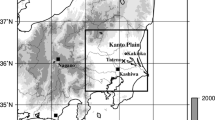Abstract
By using data from the Secondary Tibetan Plateau Science Experiment (TIPEX) in 1998, including enhanced soundings, surface observations, data from captive balloons, remote sensing, and Doppler radar (China and Japan cooperative study of GAME/ Tibet), a monitoring study on the generation and moving track of the cumulus convective systems over the Tibetan Plateau is made, and the relationship between the evolution of cloud systems over the Tibetan Plateau and 1998 flooding in China is studied. The results are as follows. 1) Analyzing the image animation and Hovmoller diagram of satellite TBB data shows that the rainstorms for the Yangtze River in the last ten days of July 1998 can be tracked regionally to the Tibetan Plateau. 2) For the period of cloud clusters passing through the Amdo station (18–19 July), monitoring observations by Doppler radar is made. The monitoring of radar echoes shows that the developing, eastward motion, and strengthening of the echoes can be frequently observed in the middle of the Tibetan Plateau. An integrated analysis and tracking of the generation, disappearance, development, and eastward motion of these convective systems by using multiple instruments is very valuable for diagnosing and predicting the influence of the plateau systems on the downstream weather situation. 3) The integrated analysis of space-time cross sections of the enhanced upper air and surface observations from TIPEX during the intensified observation period shows that the frequent development of convective clouds over the Tibetan Plateau is related with the quasi-stationary convergence of surface winds. The dynamic convergence of surface winds, the vertical shear in the upper air, and transportation of water vapor due to increasing humidity over the Tibetan Plateau played an important role in the developing and strengthening of rainstorms over the Yangtze River in 1998. 4) Meso-sale filtration analysis of the vertical distribution of water vapor over the Tibetan Plateau indicates that alternating changes of high and low water vapor distribution over the Tibetan Plateau reveals clearly that the sub-synoptic scale waves exist, whose lifetime is on the order of the hours. The revelation of the eastward motion of mesoscale waves from the Tibetan Plateau indicates that the plateau systems obviously influenced the rainstorms over the Yangtze River valley in 1998.
Similar content being viewed by others
References
Chen Lianshou, and Luo Zhexian, 2000: The impact of vortices over the Tibetan Plateau on heavy rainfall along the Yangtze River basin.Proceeding of the 2nd Session of International Workshop on TIPEX-GAME/Tibet, Kunming, China, 135–137.
Ding Yihui, 1991:Advanced Synoptic Meteorology, China Meteorological Press, Beijing, 527 pp. (in Chinese)
Higgins, R. W., and S. D., Schubert, 1993: Low-frequency synoptic-eddy activity in the Pacific storm track.J. Atmos. Sci.,50, 1672–1690.
Hoskins, B. J., I. N. James, and G. H. White, 1983: The shape, propagation and mean-flow interaction of large-scale weather systems.J. Atmos. Sci.,40, 1595–1612.
Ogura, Y. A., 1997: Life history of an intense mesoscale convective storm in Oklahoma.J. Atmos. Sci.,34, 1458–1476.
Qiao Quanming, and Zhang Yagao, 1994:Qinghai-Xizang Plateau Meteorology. China Meteorological Press, Beijing, 150–155. (in Chinese)
Tao Shiyan, and Liao Qinghai, 1999:Numerical simulation study on the formation of regional rainfall disasters. China Meteorological Press, Beijing, 8–13. (in Chinese)
Tao Shiyan, Ni Yunqi, and Zhao Sixiong, 2001:A study on the prediction of rainstorm of China in summer 1998. China Meteorological Press, Beijing, 71–73. (in Chinese)
Tao Shiyan, 1980:Rain Storms in China, Science Press, Beijing, 224 pp. (in Chinese)
Tao Zuyu, Wang Hongqing, and Wang Xiu, 1998: Mesoscale convective systems of China in 1995.Acta Meteorologica Sinica,56(2), 166–177. (in Chinese)
Wang Jizhi, and Yang Yuangqin, 2001: An integrated observed study on the relationship between the rain-storm in 1998 and large-scale circulation.The technical collection on monitoring and prediction of typhoons and rainstorms, China Meteorological Press, Beijing, 67–75. (in Chinese)
Wang Jizhi, and Yang Yuanqin, 2000:Modern Weather Engineering. China Meteorologiocal Press, Beijing, 468 pp. (in Chinese)
Wang Jizhi, Zhang Guangzhi, Yang Yuangqin, and Xu Xiangde, 2000: A study on the relationship between cumulous convective system from Tibetan Plateau and ’98 flooding in China by using ’98 TIPEX data. The Proceedings of the 2nd Session of the Interna-tional Workshop on TIPEX-GAME/Tibet, Kunming, China, 137–139.
Xu Xiangde, Li Yuefeng, Miao Qiuju; 2000a: Dynamic effects of surface moisture situation in the west of Ti-betan Plateau on regional climate changes in China.The Development on the 2nd Qinghai-Xizang Plateau science experiment (TIPEX),2, China Meteorological Press, Beijing, 195–205.
Xu Xiangde, Zhang Xuejin, Zhou Mingyu, Bai Jinyu, 2000b: Dynamic features of the impact of the thermal anomaly of Tibetan Plateau underlying surface on the drought-flood in Yangtze-Huaihe River basin.The Development on the 2nd Qinghai-Xizang Plateau science experiment (TIPEX), China Meteorological Press, Beijing,3, 1–15. (in Chinese)
Xu Xiangde and Coauthors, 2002a: A comprehensive Physical Pattern of land-air dynamic and thermal structure on the Qinghai-Xizang Plateau.Science in China,45(7D), 578–594.
Xu Xiangde, Tao Shiyan, Wang Jizhi, Chen Lianshou, Zhou Li, and Wang Xiurong, 2002b: The relationship between water vapor transport features of Tibetan Plateau - monsoon “large triangle” affecting region and drought-flood abnormality of China.Acta Meteorologica Sinica,60(3), 257–266. (in Chinese)
Ye Duzheng, and Gao Youxi, 1979:Tibetan Plateau Meteorology. Science Press, Beijing, 278 pp. (in Chinese)
Zhang Guangzhi, Xu Xiangde, and Wang Jizhi, 2000: A Dynamic Study on PBL Characteristics by Using ’98 HUBEX and TIPEX Data.The Proceedings of the 2nd Session of International Workshop on TIPEX-GAME/Tibet, Kunming, China, 58–60.
Zhang Guangzhi, Xu Xiangde, and Wang Jizhi, 2002: A dynamic study on PBL characteristics by ’98 SC-SMEX and TIPEX data.The Secand Tibetan Plateau Experiment of Atmosphere Sciences, China Meteoro-logical Press, Beijing, 12–17.
Author information
Authors and Affiliations
Rights and permissions
About this article
Cite this article
Wang, J., Yang, Y., Xu, X. et al. A monitoring study of the 1998 rainstorm along the Yangtze River of China by using TIPEX data. Adv. Atmos. Sci. 20, 425–436 (2003). https://doi.org/10.1007/BF02690800
Received:
Revised:
Issue Date:
DOI: https://doi.org/10.1007/BF02690800



